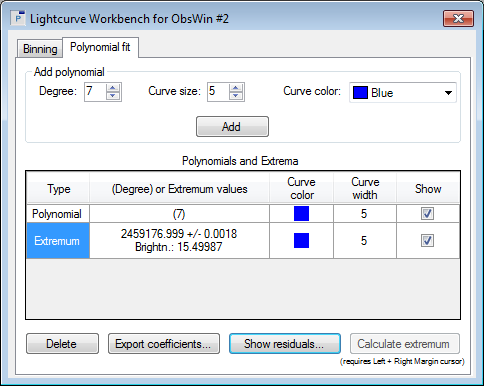|
Peranso implements a polynomial fitting routine that allows to fit standard curves up to order 50. Variable star or asteroid light curves in most cases can not simply be described by polynomial equations. Therefore, the value of polynomial fitting is in determining the time of minimum or maximum light in a light curve segment, by fitting a polynomial to the observations.
The Polynomial fitting tab is used in Peranso to fit a polynomial through either all observations in the Observations Window, or through a selected segment. In the latter case, you first have to mark the segment by setting a Left and Right Margin Cursor. See also Tutorial 9 which explains the usage of margin cursors when doing a polynomial fit.
The Polynomial fit tab contains following elements :

- The section Add polynomial consists of following fields:
- Degree: indicates the degree or order of the polynomial to be drawn. Enter a value between 1 and 50. In most applications, a quadratic or fourth-order (4) polynomial is sufficient to determine a good model.
- Curve size: defines the width in pixels of the polynomial curve
- Curve color: defines the color of the polynomial curve
- Click the Add button to add the polynomial curve to the ObsWin. If a Left and Right Margin cursor have been set, then the fitting will be limited to the indicated interval of the Observations Window. An Observations Window can have multiple Polynomials. A polynomial is implemented in Peranso as an Overlay element. Once a new polynomial has been added to the ObsWin, it will also appear in the Polynomials and Extrema table (see below).
- The Polynomials and Extrema table contains one row for each polynomial or extremum that is added to the ObsWin. The Type column shows "Polynomial" if the row represents a polynomial that was added to the table. It shows "Extremum" if the row represents an extremum that was added to the table. Use the Show field in the table to toggle visibility of the corresponding polynomial or extremum. If the selected row represents a polynomial, then the column (Degree) or Extremum values shows the degree of the polynomial. If the row represents an extremum, it shows the Time value of the extremum, together with the Brightness value.
To copy an extremum value to the Windows Clipboard, move the mouse over the (Degree) or Extremum values cell in the Polynomials and Extrema table and perform a right mouse click. A pop-up menu will appear allowing you to conclude the copy to clipboard operation.
- The bottom section contains following buttons:
- Delete: removes the selected row from the Polynomials and Extrema table, as well as the corresponding overlay from the ObsWin.
- Export coefficients: allows you to export the polynomial coefficients of the selected row to file.
- Show residuals: if you select a polynomial row in the Polynomials and Extrema table, this button will calculate the residuals resulting from the polynomial fit and display them in a new ObsWin.
- Calculate extremum: click to calculate the extremum (minimum or maximum) that is situated in the interval marked by the Margin cursors. An extremum is implemented in Peranso as an Overlay element. Once a new extremum has been added to the ObsWin, it will also appear in the Polynomials and Extrema table (see above). This button will be enabled once you have added a polynomial, and have put a Left and Right Margin cursor in the ObsWin.
In general, we recommend to position the margin cursors such that they are symmetric with the assumed location of the ToM in the middle. We also recommend to include as many observations as possible in the interval. However, one has to avoid parts of the light curve showing local minima or maxima (different from the minimum or maximum you are looking for). In other words, there should be only one minimum or maximum in the marked interval.
Polynomial maths
A (univariate) polynomial is a mathematical expression involving a sum of powers in one variable, multiplied by coefficients. It is given by:
anxn + … + a2x2 + a1x + a0
where the degree n of the polynomial represents the number of terms in the expression.
|
